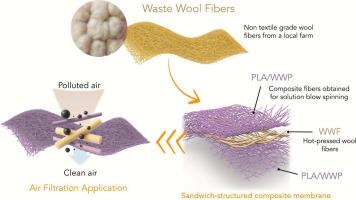三明治结构双峰聚合物纤维/废羊毛纤维生物复合膜,高性能环保空气过滤
IF 9
1区 工程技术
Q1 ENGINEERING, CHEMICAL
引用次数: 0
摘要
空气微粒造成的空气污染仍然是一个紧迫的环境挑战。为了减少空气过滤技术对环境的影响,开发可持续、高效、耐用和可重复使用的解决方案至关重要。以热压羊毛纤维为中心层,以溶液吹丝法(SBS)得到的聚乳酸(PLA)和废羊毛粉(WWP)为基料,制备了以废羊毛纤维(WWF)为基料的夹层结构膜。在不同的流量和环境条件下,对三明治结构的废羊毛基膜(S-WWM)进行了空气过滤应用测试。在PLA中加入10 wt%的WWP,可以改变溶液的粘度,改善纤维的形态。由于孔隙小,充填密度低,S-WWM在流速为32 L/min时,PM1的去除效率为99.5 %,压降为70 Pa。此外,该膜在高湿度条件下保持了高达5次重复使用周期的过滤稳定性和耐久性。这些膜具有羊毛纤维的独特性能,如优异的透气性和机械强度,并结合了PLA复合纤维的高过滤效率。研究结果表明,将废羊毛纤维与可生物降解聚合物相结合,可以产生高效的空气过滤装置,同时通过废物增值支持环境的可持续性。本文章由计算机程序翻译,如有差异,请以英文原文为准。

Sandwich-structured bimodal polymeric fiber/waste wool fiber bio-composite membrane for high-performance and eco-friendly air filtration
Air pollution due to fine airborne particles remains a pressing environmental challenge. To reduce the environmental footprint of air filtration technologies, it is crucial to develop sustainable, efficient, durable, and reusable solutions. In this work, sandwich-structured membranes based on waste wool fibers (WWF) were produced by combining a central layer of hot-pressed wool fibers with two layers of fibrous membrane based on polylactic acid (PLA) and waste wool powder (WWP) obtained by solution blow spinning (SBS) technique. The sandwich-structured waste wool based membrane (S-WWM) was tested for air filtration applications using different flow rates and environmental conditions. The addition of 10 wt% of WWP to PLA led to a modification in the solution viscosity, improving the morphology of the fibers. Thanks to the combination of small pores and low packing density S-WWM exhibited excellent PM1 removal efficiencies of 99.5 % and pressure drops of 70 Pa at flow rate of 32 L/min. Moreover, the membrane maintained filtration stability up to 5 reuse cycles and durability under high humidity conditions. These membranes are characterized by the unique properties of wool fibers, such as excellent breathability and mechanical strength combined with high filtration efficiency achieved by PLA composite fibers. The findings showed that combining waste wool fibers with biodegradable polymers results in efficient air filtration devices while supporting environmental sustainability through waste valorization.
求助全文
通过发布文献求助,成功后即可免费获取论文全文。
去求助
来源期刊

Separation and Purification Technology
工程技术-工程:化工
CiteScore
14.00
自引率
12.80%
发文量
2347
审稿时长
43 days
期刊介绍:
Separation and Purification Technology is a premier journal committed to sharing innovative methods for separation and purification in chemical and environmental engineering, encompassing both homogeneous solutions and heterogeneous mixtures. Our scope includes the separation and/or purification of liquids, vapors, and gases, as well as carbon capture and separation techniques. However, it's important to note that methods solely intended for analytical purposes are not within the scope of the journal. Additionally, disciplines such as soil science, polymer science, and metallurgy fall outside the purview of Separation and Purification Technology. Join us in advancing the field of separation and purification methods for sustainable solutions in chemical and environmental engineering.
 求助内容:
求助内容: 应助结果提醒方式:
应助结果提醒方式:


